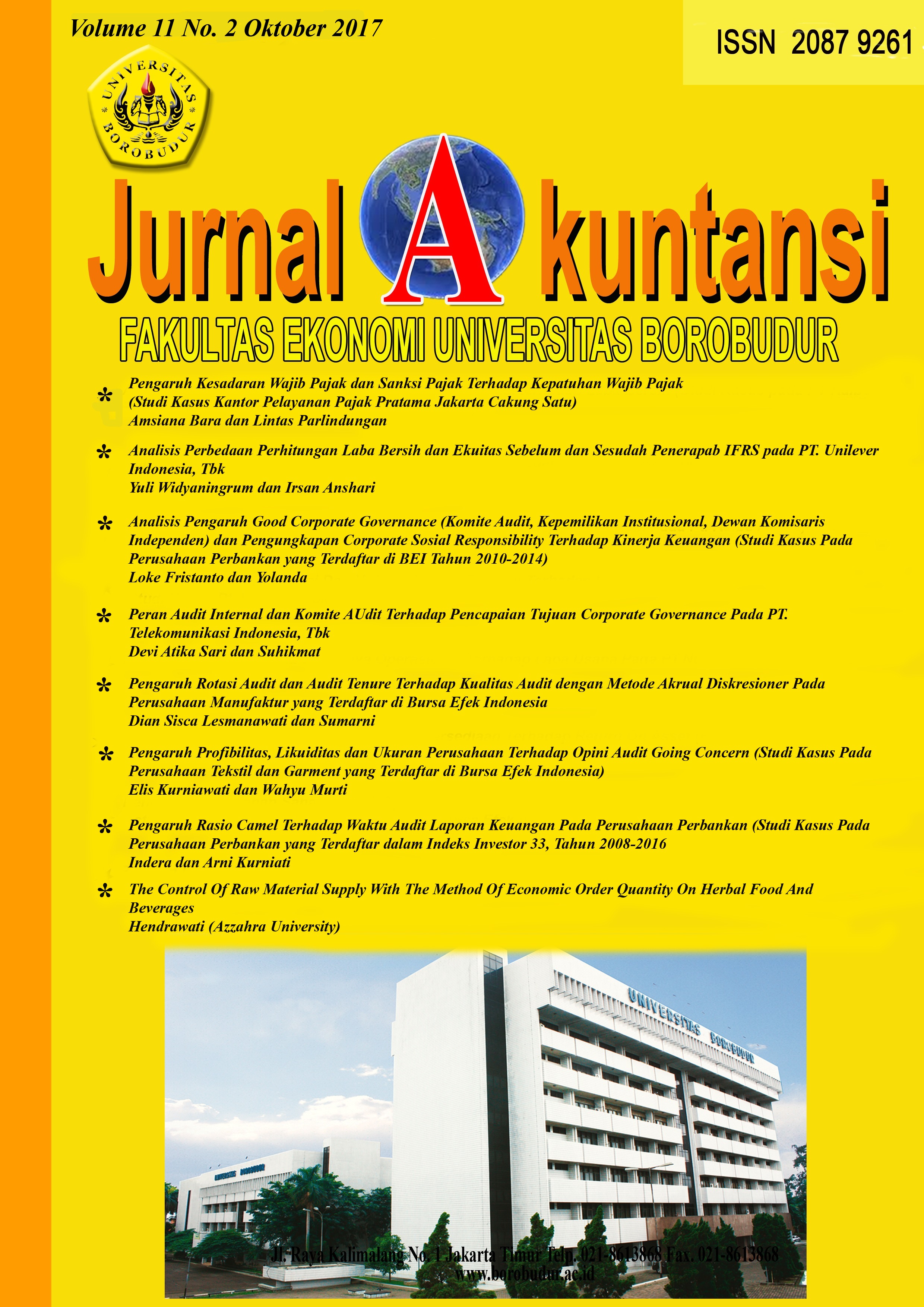THE CONTROL OF RAW MATERIAL SUPPLY WITH THE METHOD OF ECONOMIC ORDER QUANTITY ON HERBAL FOOD AND BEVERAGES
Abstract
The purpose of this research is to know the quantity of economic purchasing, safety inventory, reorder point, maximum inventory, and total inventory cost. Inventory has a great effect on the cost aspects of a company. If a company has too much inventory, it will be very detrimental because the company requires huge investment costs to keep this inventory, but, the lack of inventory also will have an impact on the production process, so, it can be detrimental to the company. The focus of this research is only in an analysis of raw material inventory control which use EOQ (Economic Order Quantity).The sampling technique in this research is purposive sampling. According to Notoatmodjo (2010), purposive sampling is a sampling based on a particular consideration such as the characteristics of the population or characteristics that have been known previously.This study uses Economic Order Quantity (EOQ) to determine the optimal amount of inventory. With this method, the company can know how many orders which are fixed and when to reorder inventory; beside that, the company know the maximum inventory. This study uses data of Wenny’s honey inventories of raw materials in 2014. Based on the calculation of the total cost of inventory before EOQ and the results of inventory planning with EOQ method which uses the application method of EOQ, the amount of inventory, the total cost, and the production process can be optimized. Keywords: Economic Order QuantityReferences
Andira, O. E. (2014). Analisis persediaan bahan baku tepung terigu menggunakan metode eoq, 201–208.
Gonzalez, J. L., & González, D. (2010). Analysis of an Economic Order Quantity and Reorder Point Inventory Control Model for Company XYZ, 1–32.
Ii, B. A. B., & Rujukan, B. (2003). No Title, 7–27.
Indah, D. R. (2017). Analisis Pengendalian Persediaan Bahan Baku pada PT . Tri Agro Palma Tamiang, 8(2).
Kumar, D. R. (2016). Economic Order Quantity (EOQ) Model. Global Journal of Finance and Economic Management, 5(1), 2249–3158. Retrieved from http://www.ripublication.com
Lisa, Y., & Supiandi, M. I. (n.d.). 3 1,2,3, (14), 1–9.
Maria, E. (2014). Pengaruh Persediaan Terhadap Peningkatan Profitabilitas Perusahaan. Jurnal Ilmiah Akuntansi Kesatuan, 2(1), 1–8.
Mulyadi. (2009). Akuntansi Biaya. Journal of Chemical Information and Modeling, 53(9), 1689–1699. https://doi.org/10.1017/CBO9781107415324.004
Munir, U. S. (2006). Universitas Sumatera Utara, 1–5. https://doi.org/10.1007/s13398-014-0173-7.2
No Title. (2012), 7–24.
Oki, S., Manado, S., Manajemen, J., Ekonomi, F., & Ratulangi, U. S. (2016). ANALISIS PERSEDIAAN BAHAN BAKU DI RUMAH MAKAN SABUAH OKI SARIO - MANADO ANALYSIS OF RAW MATERIAL INVENTORY IN RESTAURANT, 16(4), 321–330.
Pamungkas, W. T. (2011). Analisis Pengendalian Bahan Baku Menggunakan Metode EOQ (Economic Order
Quantity) Pada PT Misaja Mitra Co.Ltd.
Sciences, M. (2015). Economic Order Quantity Model : a Review Review Paper Economic Order Quantity Model : a Review, (October).
Sulak, H., & Avci, M. A. (2015). An Economic Order Quantity Model for Defective Items under Permissible Delay in Payments and Shortage, 5(1), 302–316.
Yuliana, C., Topowijono, & Sudjana, N. (2016). PENERAPAN MODEL EOQ ( Economic Order Quantity ) DALAM RANGKA MEMINIMUMKAN BIAYA PERSEDIAAN BAHAN BAKU ( Studi Pada UD . Sumber Rejo Kandangan-Kediri ). Jurnal Administrasi Bisnis (JAB), 36(1), 1–9.

